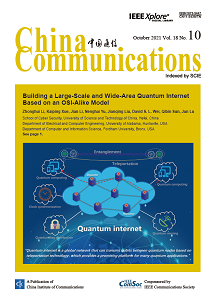Integrated sensing and communication enabled multiple beamwidth and power allocation for connected automated vehicles
IF 3.1
3区 计算机科学
Q2 TELECOMMUNICATIONS
引用次数: 0
Abstract
Connected autonomous vehicles (CAVs) are a promising paradigm for implementing intelligent transportation systems. However, in CAVs scenarios, the sensing blind areas cause serious safety hazards. Existing vehicle-to-vehicle (V2V) technology is difficult to break through the sensing blind area and ensure reliable sensing information. To overcome these problems, considering infrastructures as a means to extend the sensing range is feasible based on the integrated sensing and communication (ISAC) technology. The mmWave base station (mmBS) transmits multiple beams consisting of communication beams and sensing beams. The sensing beams are responsible for sensing objects within the CAVs blind area, while the communication beams are responsible for transmitting the sensed information to the CAVs. To reduce the impact of inter-beam interference, a joint multiple beamwidth and power allocation (JMBPA) algorithm is proposed. By maximizing the communication transmission rate under the sensing constraints. The proposed non-convex optimization problem is transformed into a standard difference of two convex functions (D.C.) problem. Finally, the superiority of the proposed JMBPA algorithm is verified by iterative solutions. The average transmission rate of communication beams remains over 3.4 Gbps, showcasing a significant improvement compared to other algorithms. Moreover, the satisfaction of sensing services remains steady.集成传感和通信为联网自动驾驶车辆提供了多种波束宽度和功率分配
联网自动驾驶汽车(cav)是实现智能交通系统的一个很有前途的范例。然而,在自动驾驶汽车场景下,感知盲区会造成严重的安全隐患。现有的车对车(V2V)技术很难突破感知盲区,保证可靠的感知信息。为了克服这些问题,基于传感与通信集成(ISAC)技术,将基础设施作为扩展传感范围的手段是可行的。毫米波基站(mmBS)传输多波束,包括通信波束和传感波束。感应波束负责感应自动驾驶汽车盲区内的物体,通信波束负责将感应到的信息传输给自动驾驶汽车。为了减少波束间干扰的影响,提出了一种联合多波束宽度和功率分配(JMBPA)算法。在传感约束下最大化通信传输速率。将所提出的非凸优化问题转化为两个凸函数的标准差分问题。最后,通过迭代解验证了所提JMBPA算法的优越性。通信波束的平均传输速率保持在3.4 Gbps以上,与其他算法相比有了显著提高。此外,对传感服务的满意度保持稳定。
本文章由计算机程序翻译,如有差异,请以英文原文为准。
求助全文
约1分钟内获得全文
求助全文
来源期刊

China Communications
工程技术-电信学
CiteScore
8.00
自引率
12.20%
发文量
2868
审稿时长
8.6 months
期刊介绍:
China Communications (ISSN 1673-5447) is an English-language monthly journal cosponsored by the China Institute of Communications (CIC) and IEEE Communications Society (IEEE ComSoc). It is aimed at readers in industry, universities, research and development organizations, and government agencies in the field of Information and Communications Technologies (ICTs) worldwide.
The journal's main objective is to promote academic exchange in the ICTs sector and publish high-quality papers to contribute to the global ICTs industry. It provides instant access to the latest articles and papers, presenting leading-edge research achievements, tutorial overviews, and descriptions of significant practical applications of technology.
China Communications has been indexed in SCIE (Science Citation Index-Expanded) since January 2007. Additionally, all articles have been available in the IEEE Xplore digital library since January 2013.
 求助内容:
求助内容: 应助结果提醒方式:
应助结果提醒方式:


